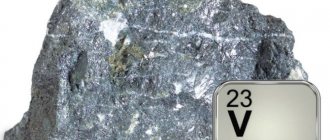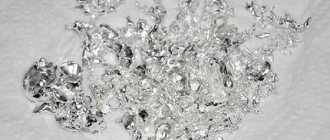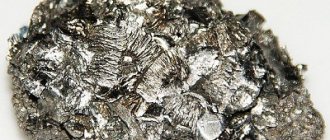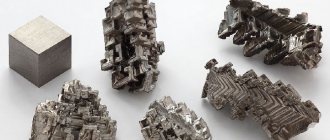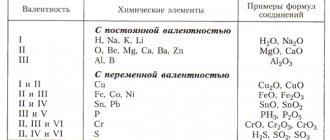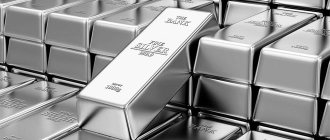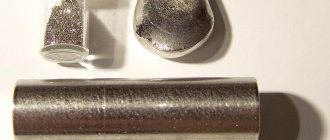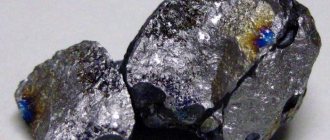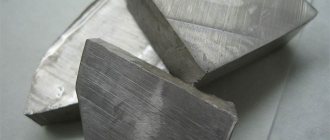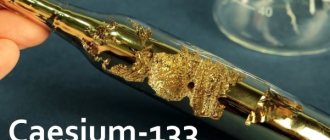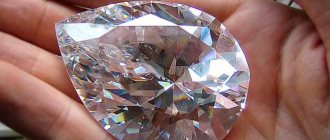Rhenium, the uses of which will be discussed below, is an element of the chemical periodic table with atomic index 75 (Re). The name of the substance comes from the Rhine River in Germany. The year of discovery of this metal is considered to be 1925. The first significant batch of the material was obtained in 1928. This element belongs to the last analogue with a stable isotope. Rhenium itself is a metal with a white tint, and its powder mass is black. Melting and boiling points range from +3186 to +5596 degrees Celsius. It has paramagnetic characteristics.
Peculiarities
The use of rhenium is not so widespread due to its exceptional parameters and high cost. At +300 °C the metal begins to actively undergo oxidation, the process of which depends on a further increase in temperature. This element is more stable than tungsten and practically does not interact with hydrogen and nitrogen, providing only adsorption.
When heated, a reaction with chlorine, bromine and fluorine is observed. Rhenium does not dissolve only in nitric acid, and when interacting with mercury, an amalgam is formed. Reaction with aqueous hydrogen peroxide produces rhenium acid. This element is the only one among refractory metals that does not form carbides. The use of rhenium has no role in biochemistry. Little information is available about all of its possible effects. Among the reliable facts is toxicity and toxicity to living organisms.
Physico-chemical characteristics
Externally, in terms of physical and chemical properties, rhenium is similar to platinoids:
- Thermal strength. The characteristics and formula do not change with prolonged heating to 2000°C or repeated jumps from overheating to overcooling.
- Catalytic characteristics.
- Increased resistance to aggressive substances. It dissolves only with nitric acid, heated sulfuric acid, alkali melts, and hydrogen peroxide.
- Oxidizes at 301°C.
- Forms alloys, compounds with halides, sulfur.
| Properties of the atom | |
| Name, symbol, number | Rhenium (Re), 75 |
| Atomic mass (molar mass) | 186.207(1) a. e.m. (g/mol) |
| Electronic configuration | [Xe] 4f14 5d5 6s2 |
| Atomic radius | 137 pm |
| Chemical properties | |
| Covalent radius | 128 pm |
| Ion radius | (+7e) 53 (+4e) 72 pm |
| Electronegativity | 1.9 (Pauling scale) |
| Electrode potential | Re←Re3+ −0.30 V |
| Oxidation states | from +7, +6, +5, +4, +3, +2, +1, 0, −1 |
| Ionization energy (first electron) | 759.1 (7.87) kJ/mol (eV) |
| Thermodynamic properties of a simple substance | |
| Density (at normal conditions) | 21.02 g/cm³ |
| Melting temperature | 3459 K (3186 °C, 5767 °F) |
| Boiling temperature | 5869 K (5596 °C, 10105 °F) |
| Ud. heat of fusion | 34 kJ/mol |
| Ud. heat of vaporization | 704 kJ/mol |
| Molar heat capacity | 28.43 J/(K mol) |
| Molar volume | 8.85 cm³/mol |
| Crystal lattice of a simple substance | |
| Lattice structure | Hexagonal (close-packed) |
| Lattice parameters | a=2.761 c=4.456 |
| c/a ratio | 1,614 |
| Debye temperature | 416.00 K |
| Other characteristics | |
| Thermal conductivity | (300 K) 48.0 W/(mK) |
| CAS number | 7440-15-5 |
Rhenium is the first in boiling point, second in refractoriness (after tungsten). Fourth in terms of “heaviness”: only osmium, platinum, and iridium are ahead. The electrical resistance is four times greater than that of tungsten and molybdenum.
Production
Rhenium is a metal that is extremely rare. In nature, it is most often found in combination with tungsten and molybdenum. In addition, impurities are present in the mineral deposits of its neighbors in the table. Rhenium is mainly mined from molybdenum deposits by associated extraction.
In addition, the element in question is mined by isolation from dzhezkazganite, a very rare natural mineral, which is named after the Kazakh settlement near the deposit. Rhenium can also be isolated from pyrites, zirconium, and columbite.
The metal is dispersed throughout the world in negligibly small concentrations. Among the well-known mining sites where it is found in significant quantities is the Kuril Island of Iturup in Russia. The deposit was discovered in 1992. Here the metal is presented in the form of a structure similar to molybdenum (ReS2).
Mining is carried out on a small site located on top of a dormant volcano. Thermal springs are active there, which indicates the expansion of the deposit, which, according to preliminary estimates, emits about 37 tons of this metal per year.
The second largest production volume is considered to be the rhenium deposit, suitable for industrial extraction of the element. It is located in Finland and is called Hitura. There, the metal is extracted from another mineral - tarkianite.
Receipt
Rhenium is obtained by processing primary raw materials, which initially have a low percentage of this material. The element is most often extracted from copper and molybdenum sulfides. Rhenium alloys are subjected to pyrometallurgical action, which is used when working with ores that undergo smelting, converting and roasting.
Excessive melting temperatures make it possible to obtain higher oxide Re-207, which is retained by special trapping devices. It happens that part of the element settles in soot after firing. From this substance, pure material can be obtained using hydrogen. The resulting powder substance is then melted directly into rhenium ingots. The use of ore for the extraction of the element in question is accompanied by the appearance of sediment in the matte. Further conversion of this composition makes it possible to isolate rhenium through exposure to certain gases.
Technological aspects
The required concentration can be achieved during production due to the properties of rhenium and the use of sulfuric acid. After undergoing special purification methods, it is possible to isolate a pure element from the ore.
This method is not very productive; the yield of a pure product is no more than 65%. This indicator varies depending on the metal content in the ore. On this basis, scientific research is regularly carried out to identify more advanced and alternative production methods.
Modern technologies make it possible to optimize the properties of rhenium obtained artificially. This solution allows you to use an aqueous solution instead of an acidic one. This makes it possible to capture significantly more pure metal during cleaning.
The most important compounds of rhenium.
A relatively small number of compounds of one, two, three, five and hexavalent rhenium are known, all of them are unstable. The most stable compounds are tetra- and heptavalent rhenium.
Rhenium dioxide, ReO2, is a non-volatile brown-black crystalline powder with metallic conductivity, stable in air at room temperature. When heated in oxygen, it turns into heptoxide. It dissolves in concentrated hydrochloric acid to form a complex compound - hexachlororhenic acid, H2[ReCl6] green-brown. Rhenium dioxide can be obtained by partial reduction of Re2O7 with hydrogen at 300° C, reductive pyrolysis of ammonium perrhenate in the presence of hydrogen or rhenium metal. It is an intermediate product in the production of rhenium.
Rhenium disulfide, ReS2, black soft crystals. It is obtained by heating powdered rhenium metal with excess sulfur in an atmosphere of hydrogen sulfide. It is a component of catalysts in petrochemical production.
Rhenium trioxide, ReO3, dark red crystals with a metallic luster. The simplest method of preparation is the decomposition of the Re2O7 complex with dioxane, Re2O7 2C4H8O2 2H2O.
Rhenium(VII) oxide, Re2O7, rhenium anhydride, light yellow, highly hygroscopic crystals. Can be obtained from elements or by oxidation of lower rhenium oxides. Intermediate product in the production of rhenium. It dissolves well in water, alcohol, and acetone. When dissolved in water it gives a colorless solution of rhenium acid. HReO4 is a strong acid, not isolated in free form.
Ammonium perrhenate, NH4ReO4, colorless crystals, soluble in water. Intermediate product in the production of rhenium.
Application
First, let's look at the main characteristics of the element in question, for which it is especially valued:
- Infusibility.
- Minimal susceptibility to corrosion.
- No deformation when exposed to chemicals and acids.
Since the price of this metal is extremely high, it is used mainly in rare cases. The main area of application of this element is the production of heat-resistant alloys with various metals, which are used in the construction of rockets and the aviation industry. As a rule, rhenium is used to produce spare parts for supersonic fighters. Such compositions include at least 6% metal.
Such a source quickly became the main means for creating jet power units. At the same time, the material began to be considered a military-strategic reserve. Specially designed thermal couples make it possible to measure temperatures over huge ranges. The element in question makes it possible to extend the service life of most aggregated metals. Rhenium, the use of which is discussed above, is also used to make springs for precision equipment, platinum metals, spectrometers, and pressure gauges.
More precisely, it uses tungsten with a rhenium coating. Due to its resistance to chemical influences, this metal is included in protective coatings against acidic and alkaline environments.
Links[edit]
- Meija, Juris; and others. (2016). "Atomic Weight of Elements 2013 (IUPAC Technical Report)". Pure and applied chemistry
.
88
(3):265–91. DOI: 10.1515/pack-2015-0305. - Lida, DR, ed. (2005). "Magnetic susceptibility of elements and inorganic compounds." CRC Handbook of Chemistry and Physics (PDF) (86th ed.). Boca Raton (FL): CRC Press. ISBN 0-8493-0486-5.
- Weast, Robert (1984). CRC, Handbook of Chemistry and Physics
. Boca Raton, FL: Chemical Rubber Company Publishing. page E110. ISBN 0-8493-0464-4. - ↑
Zhang, Yiming (01/11/2011).
"Corrected values for boiling points and enthalpies of vaporization of elements in reference books". Journal of Chemical and Engineering Data
.
56
. - "BASF Catalysts - Metal Prices". apps.catalysts.basf.com
. - Tilgner, Hans Georg (2000). Forschen Suche und Sucht (in German). Books on request. ISBN 978-3-89811-272-7.
- "Rhenium: Statistics and Information". Information about minerals
. US Geological Survey. 2011. Retrieved May 25, 2011. - Moseley, Henry (1914). “High-frequency spectra of elements. Part II". Philosophical Journal
.
27
(160): 703–713. DOI: 10.1080/14786440408635141. Archived from the original on 2010-01-22. Retrieved May 14, 2009. - ↑
Yoshihara, Hong Kong (2004).
"Discovery of the New Element 'nipponium': A Reappraisal of the Pioneering Works of Masataka Ogawa and His Son Eijiro Ogawa." Spectrochimica Acta Part B Atomic Spectroscopy
.
59
(8):1305–1310. Bibcode: 2004AcSpe..59.1305Y. DOI: 10.1016/j.sab.2003.12.027. - Eric Scerri, A Tale of the Seven Elements,
(Oxford University Press, 2013) ISBN 978-0-19-539131-2, pp.109–114 - Ehrström, Lars; Riedijk, Jan (28 November 2016). "Names and symbols of elements with atomic numbers 113, 115, 117 and 118 (2016 IUPAC Guidelines)" (PDF). Pure Appl. Chem
.
88
(12):1225–1229. DOI: 10.1515/pack-2016-0501. Retrieved April 22, 2022. - Noddack, W.; Tacke, I.; Berg, O. (1925). "Die Ekamangane". Naturwissenschaften
.
13
(26): 567–574. Bibcode: 1925NW…..13..567. . DOI: 10.1007/BF01558746. - Noddack, W.; Noddack, I. (1929). “Die Herstellung von einem Gram Rhenium.” Zeitschrift für Anorganische und Allgemeine Chemie
(in German).
183
(1):353–375. DOI: 10.1002/zaac.19291830126. - Committee on Technical Aspects of Critical and Strategic Materials, National Research Council (USA) (1968). Rhenium Use Trends: Report. pp. 4–5.
- Savitsky Evgeny Mikhailovich; Tulkina Maria Aronovna; Povarova, Kira Borisovna (1970). Rhenium alloys.
- Liu, L.G.; Takahashi, T.; Bassett, Washington (1970). "The influence of pressure and temperature on the parameters of the rhenium lattice." Journal of Solid State Physics and Chemistry
.
31
(6):1345–1351. Bibcode: 1970JPCS…31.1345L. DOI: 10.1016/0022-3697 (70) 90138-1. - ^ a b Hammond, C. R. (2004). "Elements". Handbook of Chemistry and Physics
(81st ed.). CRC Press. ISBN 978-0-8493-0485-9. - Nespor, VS; Novikov V.I.; Noskin, V.A.; Shalyt, S. S. (1968). "Superconductivity of some alloys of the tungsten-rhenium-carbon system." Soviet physics in JETP
.
27
: 13. Bibcode: 1968JETP ... 27 ... 13N. - Haynes, William M., ed. (2011). CRC Handbook of Chemistry and Physics (92nd ed.). CRC Press. clause 12.60. ISBN 978-1439855119.
- Daunt, J. G.; Lerner, E. "Properties of Superconducting Mo-Re Alloys". Defense Technical Information Center. Archived from the original on 2017-02-06.
- Johnson, Bill (1993). "How to change the rate of nuclear decay". math.ucr.edu
. Retrieved February 21, 2009. - Bosch, F.; Faestermann, T.; Friese, J.; and others. (1996). "Observation of the bound state β
- decay of fully ionized 187 Re: 187 Re- 187 Os Cosmochronometry."
Physics Review Letters
.
77
(26):5190–5193. Bibcode: 1996PhRvL..77.5190B. DOI: 10.1103/PhysRevLett.77.5190. PMID 10062738. - Audi, G.; Kondev F.G.; Wang, M.; Huang, W. J.; Naimi, S. (2017). "NUBASE2016 Nuclear Properties Assessment" (PDF). Chinese Physics
C.
41
(3): 030001. Bibcode: 2017ChPhC..41c0001A. DOI: 10.1088/1674-1137/41/3/030001. - Holleman, Arnold F.; Wiberg, Egon; Wiberg, Nils (1985). "Rhenium". Lehrbuch der Anorganischen Chemie
(in German) (91–100 ed.). Walter de Gruyter. pp. 1118–1123. ISBN 978-3-11-007511-3. - ^ ab Glemser, O. (1963) "Ammonium perrhenate" in Handbook of Preparative Inorganic Chemistry
, 2nd ed., G. Brouwer (ed.), Academic Press, NY., Vol. 1. pp. 1476–85. - Goodman, J.T.; Rauchfuss, T. B. (2002). "Tetraethylammonium tetrathioperrhenate [ReS 4 ]". Inorganic syntheses
.
33
: 107–110. DOI: 10.1002/0471224502.ch2. ISBN 0471208256. - ^ abcdef Greenwood, Norman N.; Earnshaw, Alan (1997). Chemistry of elements
(2nd ed.). Butterworth-Heinemann. ISBN 978-0-08-037941-8. - Goodman, J.T.; Rauchfuss, T. B. (2002). Tetraethylammonium tetrathioperrhenate [Et 4 N] [ReS 4 ]
.
Inorganic syntheses. 33
. pp. 107–110. DOI: 10.1002/0471224502.ch2. ISBN 9780471208259. - Qin, Jiaqian; He, Duanwei; Wang, Jianghua; Fang, Laming; Ley, Lee; Li, Yongjun; Hu, Juan; Coe, Zili; Bee, Ian (2008). "Is rhenium diboride a superhard material?" Modern materials
.
20
(24): 4780–4783. DOI: 10.1002/adma.200801471. - Breimar, Joseph; Steimann, Manfred; Wagner, Barbara; Beck, Wolfgang (1990). "Addition of a carbonylmetallatene nucleophile to the cationic complex Alkin-Komplexe [CpL2M (η2-RC≡CR)] + (M = Ru, Fe): μ-η1: η1-Alkin-verbrückte Komplexe". Chemische Berichte
.
123
: 7. DOI: 10.1002/cber.19901230103. - Schmidt, Stephen P.; Trogler, William S.; Basolo, Fred (1990). Pentacarbonylrhenium halides
.
Inorganic syntheses. 28
. pp. 154–159. DOI: 10.1002/9780470132593.ch42. ISBN 978-0-470-13259-3. - Michael A. Urbancic; John R. Shapley (1990). Pentacarbonylhydridorenium
.
Inorganic syntheses. 28
. pp. 165–168. DOI: 10.1002/9780470132593.ch43. ISBN 978-0-470-13259-3. - Hudson, A. (2002) "Methyltrioxorenium" in Encyclopedia of Reagents for Organic Synthesis
. John Wiley & Sons: New York, ISBN 9780470842898, DOI: 10.1002/047084289X. - Emsley, John (2001). "Rhenium". Nature's Building Blocks: A-Z Guide to the Elements. Oxford, England, UK: Oxford University Press. pp. 358–360. ISBN 978-0-19-850340-8.
- ^ ab Ruskias, George (1974). "Recent advances in rhenium chemistry". Chemical Reviews
.
74
(5): 531. DOI: 10.1021/cr60291a002. - Anderson, Steve T. "Minerals Yearbook 2005: Chile" (PDF). US Geological Survey. Retrieved October 26, 2008.
- Korzhinsky, M.A. Tkachenko, S.I.; Shmulovich K.I.; Taran Y.A. Steinberg, G. S. (2004-05-05). "Discovery of the pure mineral rhenium at Kudryavy Volcano." Nature
.
369
(6475): 51–52. Bibcode: 1994Natur.369…51K. DOI: 10.1038/369051a0. - Kremenetsky, A.A.; Chaplygin I.V. (2010). “Concentration of rhenium and other rare metals in gases of Kudryavy volcano (Iturup Island, Kuril Islands).” Geoscience Reports
.
430
(1): 114. Bibcode: 2010DokES.430..114K. DOI: 10.1134/S1028334X10010253. - Tessalina, S.; Yudovskaya, M.; Chaplygin, I.; Birck, J.; Kapmas, F. (2008). "Sources of unique rhenium enrichment in fumaroles and sulfides of Kudryavy volcano." Geochimica et Cosmochimica Acta
.
72
(3): 889. Bibcode: 2008GeCoA..72..889T. DOI: 10.1016/j.gca.2007.11.015. - "Mineral rhenite". Amethyst galleries.
- Magyar, Michael J. (January 2012). "Rhenium" (PDF). Mineral Reviews
. US Geological Survey. Retrieved September 4, 2013. - "Minor Metal Prices". minormetals.com. Retrieved February 17, 2008.
- Jump up
↑ Harvey, Jan (2008-07-10). "Analysis: Super-hot rhenium metal could hit 'platinum price'". Reuters India. Retrieved October 26, 2008. - ^ abc Naumov A.V. (2007). "Rhenium Rhythms". Russian Journal of Non-Ferrous Metals
.
48
(6):418–423. DOI: 10.3103/S1067821207060089. - ^ abc Magyar, Michael J. (April 2011). "Minerals Yearbook: Rhenium, 2009" (PDF). US Geological Survey.
- Bhadeshia, HKDH "Nickel-based superalloys". Cambridge university. Archived from the original on 2006-08-25. Retrieved October 17, 2008.
- Kantor, B.; Grant, Patrick Assender Hazel (2001). Aerospace Materials: A Text Based on Oxford-Kobe Proceedings. CRC Press. pp. 82–83. ISBN 978-0-7503-0742-0.
- Bondarenko, Yu. A.; Kablov E.N.; Surova, V.A.; Echin, A.B. (2006). "The influence of high-gradient directional crystallization on the structure and properties of a rhenium-containing single-crystal alloy." Metallurgy and Heat Treatment
.
48
(7–8): 360. Authorization code: 2006MSHT ... 48..360B. DOI: 10.1007/s11041-006-0099-6. - "Fourth generation monocrystalline nickel-based superalloy" (PDF).
- ↑
Koizumi, Yutaka;
and others. "Development of a Next-Generation Single-Crystalline Nickel-Based Superalloy" (PDF). Proceedings of the Turbine International Gas Congress, Tokyo November 2-7, 2003
. - Walston, S.; Cetel, A.; MacKay, R.; O'Hara, K.; Duhl, D.; Dreshfield, R. "Co-development of a fourth-generation monocrystalline superalloy" (PDF). Archived from the original (PDF) on October 15, 2006.
- Fink, Paul J.; Miller, Joshua L.; Konitzer, Douglas G. (2010). "Rhenium Recovery - Developing an Alloy Using an Economically Strategic Element." JOM
.
62
(1): 55. Bibcode: 2010JOM…. 62a..55F. doi:10.1007/s11837-010-0012-z. - Konitzer, Douglas G. (September 2010). "Design in an era of limited resources". Archived from the original on 2011-07-25. Retrieved October 12, 2010.
- Lassner, Eric; Schubert, Wolf-Dieter (1999). Tungsten: properties, chemistry, element technology, alloys and chemical compounds. Springer. p. 256. ISBN 978-0-306-45053-2.
- "Tungsten-Rhenium - Union City's Thread". Union City Thread
. Retrieved April 5, 2022. - Cherry, Pam; Duxbury, Angela (1998). Practical Radiation Therapy Physics and Equipment. Cambridge University Press. paragraph 55. ISBN 978-1-900151-06-1.
- Asamoto, R.; Novak P.E. (1968). "Tungsten-Rhenium Thermocouples for High Temperature Use". Review of Scientific Instruments
.
39
(8): 1233. Bibcode: 1968RScI ... 39.1233A. DOI: 10.1063/1.1683642. - Blackburn, Paul E. (1966). "Rhenium Vapor Pressure". Journal of Physical Chemistry
.
70
: 311–312. DOI: 10.1021/j100873a513. - Earl, G.D.; Medikonduri, R.; Rajagopal, N.; Narayanan, V.; Roddy, P. A. (2005). "Variability of tungsten-rhenium filament life in low-pressure oxygen environment." IEEE Transactions on Plasma Science
.
33
(5):1736–1737. Bibcode: 2005ITPS...33.1736E. DOI: 10.1109/TPS.2005.856413. - Jump up
↑ Ede, Andrew (2006).
Chemical Element: Historical Perspective
. Greenwood Publishing Group. ISBN 978-0-313-33304-0. - ↑
Ryashentseva, Margarita A. (1998).
"Rhenium-containing catalysts in reactions of organic compounds." Russian chemical reviews
.
67
(2): 157–177. Bibcode: 1998RuCRv..67..157R. DOI: 10.1070/RC1998v067n02ABEH000390. - Jump up
↑ Mol, Johannes C. (1999).
"Metathesis of Olefins on Supported Rhenium Oxide Catalysts". Catalysis today
.
51
(2):289–299. DOI: 10.1016/S0920-5861(99)00051-6. - Angelides, Tennessee; Rosopoulou, D. Tsitsios V. (1999). "Selective recovery of rhenium from spent reforming catalysts". Ind. Eng. Chem. Res
.
38
(5): 1830–1836. DOI: 10.1021/ie9806242. - Birch, Robert (1978). "The oxidation state of rhenium and its role in platinum-rhenium" (PDF). Review of Platinum Metals
.
22
(2): 57–60. - ^ ab Dilworth, Jonathan R.; Parrott, Suzanne J. (1998). "Biomedical chemistry of technetium and rhenium". Chemical Society Reviews
.
27
: 43–55. DOI: 10.1039/a827043z. - "Information on Tungsten-188 and Rhenium-188 Generators". Oak Ridge National Laboratory. 2005. Archived from the original on 2008-01-09. Retrieved February 3, 2008.
- ↑
Baker, Monya (April 22, 2013).
"Radioactive bacteria attack cancer". Nature
. DOI: 10.1038/nature.2013.12841. - Cipriani, Cesidio; Desantis, Maria; Dahlhoff, Gerhard; Brown, Shannon D.; Wendler, Thomas; Olmeda, Mar; Peach, Gunilla; Eberlein, Bernadette (07/22/2020). "Personalized radiotherapy for NMSC using rhenium-188 skin cancer therapy: a long-term retrospective study". Journal of Dermatologic Treatment
: 1–7. DOI: 10.1080/09546634.2020.1793890. ISSN 0954-6634. - Colton, R.; Pavlin R.D. (1962). "An Outline of the Chemistry of Technetium". Quarterly Reviews, Chemical Society
.
16
(4): 299–315. DOI: 10.1039/QR9621600299. - Emsley, J. (2003). "Rhenium". Nature's Building Blocks: A-Z Guide to the Elements
. Oxford, England, UK: Oxford University Press. pp. 358–361. ISBN 978-0-19-850340-8. - Haley, Thomas J.; Cartwright, Frank D. (1968). "Pharmacology and toxicology of potassium perrhenate and rhenium trichloride." Journal of Pharmaceutical Sciences
.
57
(2):321–323. DOI: 10.1002/jps.2600570218. PMID 5641681.
Interesting Facts
Rhenium is also used to make special contacts. They have the property of self-cleaning in the event of a short circuit. On ordinary metals, an oxide remains that does not allow current to pass. Current also passes through rhenium alloys, but it does not leave any traces behind. In this regard, contacts made of this metal have a long service life.
The most important aspect of rhenium's use is its ability to create catalysts that help produce certain components of gasoline fuels. The possibility of using the chemical element in the petroleum products industry has led to a several-fold increase in its demand in the relevant market. The world has become seriously interested in this unique material.
Where is it used?
Manufacturers appreciated the advantages of rhenium: heat resistance, durability, hardness.
However, the scale of use is dictated by the price: rhenium is in demand where there is nothing to replace it. Alloys are mainly used.
Rhenium as a metal is in demand in the following industries:
- Aircraft and rocketry. The main consumer of metal (70%). Supersonic aircraft engines for the defense and civil sectors. The presence of rhenium in the material alloy increases the carrying capacity of the liner.
The engine turbine of new modifications of airliners (Airbus, Bombardier, others) requires 5.39 kg of rhenium.
- Electronics, electrical engineering . Special purpose incandescent lamps, X-ray, cathode ray tubes, thermocouples, contacts, filling of precision instruments.
Oxidized rhenium contacts self-clean: the oxide evaporates.
- Chemistry, oil refining . The metal is valued as a renewable catalyst. Used for the production of elite brands of gasoline.
- Nuclear Medicine . Metal isotopes are used to diagnose and treat complex forms of illnesses, including oncology.
The know-how of Russian scientists – rhenium-188 – is in demand around the world. There are no analogues to this product.
- The science. The radioactive isotope rhenium-187 is a marker for establishing the age of geological formations.
A new area of application is coating. The process of applying metal to a surface is called refining. It is used to cover the inside surfaces of tanks and containers for aggressive chemicals.
The disadvantages of the metal that hinder its use are rarity, difficulty of extraction, and high price.
Reserves
It is worth noting that the world reserve of rhenium is at least 13 thousand tons in molybdenum and copper deposits alone. They are the main sources of this component in the metallurgical industry. More than 2/3 of all rhenium on the planet is contained in such configurations. The remaining third represents secondary residues. If we reduce all calculations of reserves to a single denominator, they should be enough for at least three hundred years. Recycling was not taken into account in the scientists' calculations. Similar projects have been developed for a long time, some of them have proven their worth.
CONTENT
- 1. History
- 2 Characteristics 2.1 Isotopes
- 2.2 Compounds 2.2.1 Halides and oxyhalides
- 2.2.2 Oxides and sulfides
- 2.2.3 Other connections
- 2.2.4 Organorhenium compounds
- 2.2.5 Nonahydridorchenate
- 4.1 Alloys
Price
Prices for products in most categories are determined by the availability and demand of the product. A component such as rhenium is one of the most expensive metals in the world, so not every manufacturer can afford it, although it has unique properties that make it possible to level out the costs of its expensive use. Moreover, rhenium has parameters that no other metal has. Its characteristics are ideal for creating space and aviation structures. It is not surprising that the price of rhenium is high, although it meets all the indicators characteristic of this unique material.
Already in 2011, the average cost of rhenium was about 4.5 US dollars per gram. Subsequently, no downward trends in prices were observed. Often the final cost depends on the degree of metal purification. The price of the material can reach a thousand dollars or more.
What is
Externally, rhenium resembles platinum or steel: the same cold shiny, silvery-white. It can be distinguished by its powder form – dark gray to black.
Belongs to the transition metals of the rare dispersed group:
- It is not classified among the noble ones, but surpasses them in rarity and utilitarian characteristics.
- In composition, it is a mixture of isotopes 185 and 187 (ratio 2:1). Rhenium-185 is stable, rhenium-187 is radioactive : half-life is more than 43 billion years.
The international designation is Re (Rhenium), the formula of the substance is Re.
History of discovery
This element was discovered by German chemists Ead and Walter Noddack in 1925. They carried out research using columbispectral analysis in the laboratory of the Siemens and Shake group. After this event, a corresponding report was given at a meeting of German chemistry specialists in Nuremberg. A year later, a team of scientists isolated the first two milligrams of rhenium from molybdenum.
The element was obtained in relatively pure form only in 1928. To obtain one milligram of the substance, it was necessary to process over 600 kilograms of Norwegian molybdenum. Industrial production of this metal also started in Germany (1930). The capacity of the processing plants made it possible to produce about 120 kg of metal annually. At that time, this completely satisfied the need for rhenium on the entire world market. In America, the first industrial 4.5 kg of the unique metal was obtained in 1943 by processing concentrated molybdenum. It was this element that became the last stable isotope metal to be discovered. All other analogues discovered earlier, including artificially, did not have similar properties.
Natural reserves
Today, according to the natural reserves of the metal in question, the list of deposits can be arranged in the following order:
- Chilean mines.
- USA.
- Iturup Island, where deposits are estimated to be up to 20 tons per year (in the form of volcanic gas eruptions).
In the Russian Federation, semi-element deposits of the hydrogenic type are assessed as areas that have the maximum potential of porphyry copper and copper-molybdenum ores. In total, judging by the forecasts of experts, rhenium deposits in Russia amount to 2900 tons (76% of the state resource). The lion's share of these deposits is located in the Moscow region coal basin (82%). The next field in terms of reserves is the Briketno-Zheltukhinsky basin in the Ryazan region.
Precautions[edit]
Very little is known about the toxicity of rhenium and its compounds because they are used in very small quantities. Soluble salts such as rhenium halides or perrhenates may be hazardous due to elements other than rhenium or due to rhenium itself. [70] Only a few rhenium compounds have been tested for their acute toxicity; two examples are potassium perrhenate and rhenium trichloride, which were administered to rats as a solution. Perrhenate had an LD 50 value of 2800 mg/kg after seven days (this is very low toxicity, similar to that of table salt), and rhenium trichloride showed an LD 50 of 280 mg/kg. [71]
